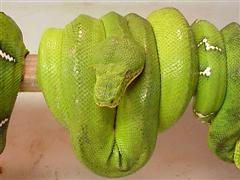Boa - Emerald tree
Scientific Name: Corallus caninus
Tue, 15th July, 2025 - 9:39 pm GMT
Sponsor Ads:

Alternative Name
Scientific Name: Corallus caninusBasic Info
Like the name implies, the Emerald Tree Boa has a brilliant light green color. They are also characterized by the presence of white markings. At maturity, the Emerald Tree Boa reaches a maximum size of six to eight feet. As with other tree boas these are slender snakes. Their maxillary teeth are shed periodically. The heat pits around their lips are prominent.
Health
The Emerald Tree Boa is considered relatively difficult to care for two reasons. The first is that they are a very aggressive snake, and the second is that they have high humidity requirements. The temperature of their cage should be about 85 degrees Fahrenheit during the day. Humidity should be high; between 85% and 100%, which can be accomplished by misting the habitat several times a day, or by using an automated misting system. Emerald Tree Boas are accustomed to 12 hours a day of light, due to living near the equator. In captivity, they should be exposed to the same. This snake is most active at night. Breeding The cycling of temperature, humidity, and lighting is a very important factor in getting the Emerald Tree Boa to reproduce. In other words, an environment closest to their natural environment is best. Temperatures should cycle between 70 and 80 degrees Fahrenheit, which should correspond to a change in humidity from 85 to 100%, this change in temperature and humidity should be consistent with the 12 hour lighting cycle. Gravid females should be kept at higher temperatures around 90 degrees Fahrenheit. Females should be introduced into the male's habitat for best results. Emerald Tree Boas are live bearers, and will take roughly six to seven months to gestate. Roughly 7 to 14 baby snakes will normally be produced for each breeding. Babies can be red, yellow, or green but are most often red. As they mature they will change to green after roughly nine months. Juveniles should be fed pinky mice, if the babies do not want to eat pinkes try fuzzies.Habitat
Found in the Amazon Rainforest of South AmericaBehavior
The Emerald Tree Boa's beautiful green coloration is striking. Their beautiful appearance is making the Emerald Tree Boa a highly desirable part of many snake enthusiast's collections. The Emerald Tree Boa is strictly arboreal. It prefers to spend all of its time in the trees. If an Emerald Tree Boa is found on the ground, it is usually because there is something wrong with it. Emerald Tree Boas like to coil over tree branches and they rest their heads roughly in the middle of the coils, as is the case with many tree snakes. The Emerald Tree Boa may not be well suited for beginners because of its highly aggressive temperament and its high humidity requirements. They are so aggressive that some enthusiasts call them "Legless Werewolves". In some cases they can be handled, though this requires a lot of work and is an exception rather than a rule. As with all tree boas they have longer teeth to aid in capturing birds in the wild. As a result these can inflict a painful bite. As a rule when keeping these snakes one should stick to "look but don't touch". With the arboreal nature of the Emerald Tree Boa, its habitat should be large, but should lean towards the tall side. It should contain plenty of plant life and branches for the snake to live in. These are generally not the most active snakes, sometimes they will go for weeks and only move and inch or so in position. The average lifespan of the Emerald Tree Boa is 15 to 20 years.Origin
South AmericaHistory
The Emerald Tree Boa, or "Corallus caninus", is found in the Amazon Rainforest of South America. They mostly inhabit Brazil, but can be found in Colombia, Peru, Ecuador and Bolivia. They are found in altitudes between sea level and 1000 feet.Common Foods
N/ASponsor Ads:
For those who live in the past, there is no future. "If you take no part in the design of your future, it will be designed for you by others." -- Edward de Bono
Boa - Emerald tree
Coded by: BGID® | ALL RIGHTS RESERVED Copyright © 2000-2025
Disclaimer | Privacy | Report Errors / Contact | Credits


 Preparing For China. China is growing their military. China Military Technology - can it keep up with the US?
Preparing For China. China is growing their military. China Military Technology - can it keep up with the US?  versus
versus 

 versus
versus 
 This Thread is about the North Korean Military itself - the kind of army, navy, and air force they have.
This Thread is about the North Korean Military itself - the kind of army, navy, and air force they have. 
 versus
versus 
 versus
versus  versus
versus